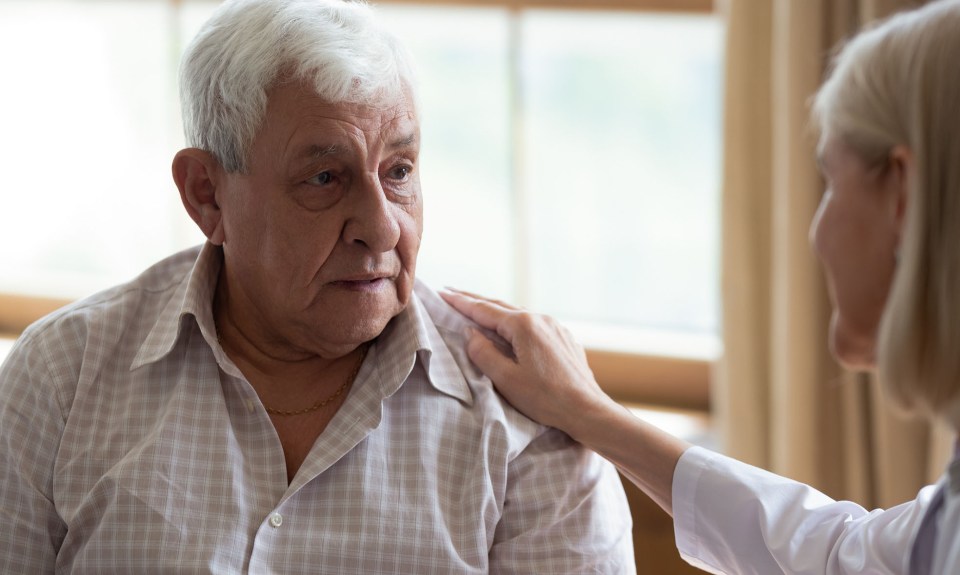It’s your first week on the brain injury service and you’ve just met your new patient. David is 19 years old and recovering from a traumatic brain injury. He’s in an enclosure bed and needs help with mobility, cognition and basic hygiene. You have planned to work on balance and mobility tasks in the gym, and David has agreed to participate. Things are going well until David becomes unexpectedly frustrated. He does not want to wear his helmet. You attempt to calm him down but it’s not working. He begins yelling and pushing you away. It’s causing a scene because other patients and staff are nearby. This is not how you planned to start your day.
Maybe you’ve had a patient like David before. Or maybe instead of agitation, your patient was non-compliant with important tasks or made sexually inappropriate comments. How did you respond? Did you know what to do?
Behavior issues are actually pretty common in the acquired brain injury (ABI) population. Studies suggest behavioral deficits, including agitation, impulsivity and restless behavior, occur in up to 70% of patients hospitalized with different types of brain injury (McNett, Sarver, & Wilczewski, 2012). Many of these patients are experiencing post-traumatic amnesia, which is a stage of recovery involving disorientation, distractibility and decreased short-term memory (Parker et al., 2022).
It’s important to feel prepared when working with this population to facilitate functional outcomes and successful community re-entry. Luckily, there are several things we can do to positively impact behavior in clinical practice.
Summary
- Interacting with Patients with ABI
- General Behavior Concepts
- What to Do if Your Patient becomes Aggressive
- Environmental Interventions
- Scheduling Considerations
- Maximize Orientation
- Activity Considerations
- What to Do If Your Patient is Refusing
- How to Handle Inappropriate Comments or Touching
- Putting it All Together
Interacting with Patients with ABI
Set the scene for a positive encounter upon your first arrival to the room. Think about verbal and nonverbal factors that impact the patient’s experience. Some behaviors can be avoided by careful interaction choices.
- Use a social greeting. A social greeting can help relax the patient and show that you’re a friendly person. Make sure you also re-introduce yourself in case they don’t remember who you are.
- Speak slowly and clearly and be sure to be simple and concise. This gives the patient time to process the information.
- Avoid repeatedly disagreeing. It’s important to correct inaccuracies, but not to the point of an argument. A good rule of thumb is to correct the error when it first occurs, but don’t insist on your viewpoint if the patient claims he or she is right.
- Explain your intentions. Explaining intentions ahead of time can help avoid a startle reaction, which can lead to agitation.
- Avoid sudden movements/touching. It’s suggested to use a greeting and initiate conversation before touching a patient with ABI. And when you do touch them, use gentle pressure as opposed to grabbing and holding. You’ll also want to approach them from the front so they can see you coming. And it’s important to get on their level, so consider sitting on a chair rather than towering over them.
- Re-direction. Switch topics or activities upon signs of patient frustration. Sometimes distracting the patient helps with avoiding a full-blown outburst.
- Formally end your contact. Often, the patient with ABI isn’t aware of social cues that you intend to exit the room. This can make it hard to end a conversation or move on to the next thing. Use concrete statements such as, “The therapy session has ended, and it’s time for me to leave the room.”
General Behavior Concepts
It’s also important to consider basic behavior principles. You don’t have to be an expert, but understanding these concepts can re-focus your perspective.
- All behaviors have a purpose. We have to understand why behaviors occur before we can have a chance to change them.
- Minimize rather than eliminate. Minimizing problematic behavior is often more realistic than eliminating behaviors all together.
- Manage your own behavior. Regardless of what’s happening in the environment, we can always manage our own behavior more easily than that of another person.
- Positive therapeutic relationship. A positive rapport can reduce behavior issues and predict a more successful outcome.
- Be proactive vs. reactive when possible. Anticipate scenarios ahead of time by considering your approach. In other words, prevent a mess before it happens rather than mopping it up afterward.
- Re-direction is not a distraction but a crucial therapeutic task in itself. Sometimes as a therapist, it can feel unsettling when you don’t accomplish the plan. Maybe you intended to rehearse a toilet transfer but you instead spent 20 minutes in a dark room de-escalating after an outburst. This may have been the most therapeutic thing for the patient in that moment.
What to Do if Your Patient is Aggressive
Agitation is a state of verbal or physical aggression that occurs when the brain is healing from injury. Although startling in the moment, it’s a manifestation of the patient’s injury and not a personal attack. Agitation is complex and impacted by both intrinsic and environmental factors. Caregivers can manage agitation by learning strategies and techniques to promote a safe experience. How to respond in the moment:
- Remove and minimize triggers. Try to identify if something specific is setting the patient off. Maybe they’re upset about being corrected or criticized. Or maybe it’s performing a difficult task, feeling rushed or getting out of a routine. Sometimes we ourselves are even the agitating agent.
- Allow time for de-escalation (re-direction). Try changing the subject to a more neutral topic or switching the patient to a different task that distracts them and is less frustrating. Sometimes, a complete rest break is needed where you quietly pause and give the patient time to recover.
- If physical harm occurred, explain that it’s not acceptable. Be concrete about the inappropriateness of the behavior. The patient may be unaware of actions and consequences.
- Talk about the behavior and related triggers. When the patient is calm, and if he/she has the capacity to discuss the behavior, ask about what happened and what triggered them. But if the patient is not capable of discussing the incident, don’t prolong the outburst by reminding them of the trigger.
Environmental Interventions
It’s important to remember that behavior outbursts can occur when the brain is overstimulated. The brain has limits on how much it can process at one time when it is healing. There are many things we can do from an environmental standpoint to lower that stimulation level.
- Reduce stimuli. Start with reducing light, noise and other distractions, especially at night. Think about placing the patient in bed, drawing the curtains and turning off the TV. You can also look at the layout of the room and make sure it’s not overcrowded with clutter.
- Monitor voice/communication. Staff and family should speak in low voices, slowly and one at a time.
- Avoid/minimize restraints. Sometimes restraints are necessary to keep the patient safe. But restraints can also agitate the patient. Look for opportunities to provide care in the least restrictive setting possible while still being safe. Can a one-on-one sitter be used for re-direction and impulsivity management instead? Is a low bed appropriate for the patient? If restraints are indicated, try to consider non-contact options like an enclosure bed where the patient has freedom to move without being held down.
- Minimize tubes and lines. Tubes and lines can understandably aggravate and distract the patient. If unavoidable, consider covering lines with an abdominal binder or clothing.
- Create a familiar environment. Allow family to bring in personal possessions and incorporate these items into therapy. Utilize familiar music as this can make the patient comfortable and encourage participation.
- Consider the number of visitors. Make sure you limit the number of visitors at one time. Sometimes even the most supportive family members can be too overwhelming when several are present at the same time.
Scheduling Considerations
- Consistent schedule and staff. A consistent schedule helps the patient have a familiar routine and know who and what to expect each day.
- Shorter sessions spaced throughout the day. Not only do ABI patients have cognitive and physical fatigue affecting their activity tolerance, but they also have limits on how much frustration they can handle. By spreading out sessions, we can sometimes be more successful in avoiding outbursts.
- Sleep cycle and quality. It’s also helpful to monitor the patient’s sleep patterns. A sleep log enables the hour by hour description of the patient’s sleep. This can be helpful for identifying disruptions in sleep which can impact daytime agitation and schedule choices. Some patients do better at a certain time of day based on their alertness.
Maximize Orientation
- Frequent re-orientation by staff and family members. Because agitation occurs during post-traumatic amnesia, the patient is often confused about basic information like where they are, what has happened or what day it is. Reviewing this information can help remind them of the situation and feel less threatened.
- Obtain hearing devices or vision aides from home to improve orientation. It sounds obvious, but sometimes patients don’t have these devices with them and it only adds to the confusion and frustration level.
Activity Considerations
- Allow patient to pace (if safe) or be walked/wheeled around by staff. Many ABI patients have motor restlessness, where they feel better when they’re moving, and have a strong urge to move. With that being said, mobile patients also benefit from a closed unit with extra sensors for safety.
- Timed toileting. Toileting in advance of need is also an important concept. This is where patients use the toilet on a timed schedule, such as every two hours. This can help with behavior because sometimes agitation is in response to a physical need not being met. Offering this schedule can help when you’re working with someone who may not be able to initiate or express the need on his/her own.
- Diversional activities for the patient during down time. Activities can occupy and distract the patient so they don’t perseverate on other things. The activities can be really basic like playing cards, magazines or activity kits where the patient has something to sort or count.
Team Approach
- Co-treatments with neuropsychologist/behavior contract. It can be helpful to have a clinical psychologist attend the session for feedback and assist with challenging behaviors. The psychologist can model strategies or assist with an actual behavior contract if needed.
- Behavior rounds with interdisciplinary group for planning and discussion. Some hospitals offer a behavior huddle where team members review behaviors of applicable patients as well as triggers and strategies for management. This helps to proactively address situations ahead of time.
- Alternating caregivers when necessary. Even though it’s important to promote a consistent schedule, there are situations where patients get agitated at a specific staff member. In these situations, it may be more productive to have someone fill in for you. This can be someone nearby in the hallway or someone you call to the room.
- Incorporate the patient’s family members. Educate family members on what is happening and the concept of re-direction instead of confrontation. Educate them on how to be supportive but also on the importance of taking a break.
What to Do if Your Patient is Refusing
Non-compliance is another challenging behavior in patients with brain injury. This is when the patient is unwilling to participate in daily living activities. Sometimes the refusal is in response to really important things, such as taking medications, getting dressed or eating.
- Provide choices. Sometimes non-compliance is due to the patient feeling forced to do something. Providing choices can give the patient a sense of control again. When providing choices, present the options as an either/or decision, as too many choices can be overstimulating.
- Bargaining. Identify something that motivates the patient and use it as a negotiating tool. If the patient participates in your task first, he/she can do the more enjoyable task next.
- Positive reinforcement. Reward a positive behavior with a compliment or praise to hopefully make it more likely to occur in the future.
- Avoid power struggles. Avoid saying things like, “You have to do this because I said so.” This will likely be perceived in a negative manner and not help your case.
- Adjust the task to meet the patient’s expectations. Sometimes patients will have an unrelated request that they insist on doing before participating in your task. For example, they may want you to reorganize their closet before agreeing to put on pants. If it’s safe to do so, you may want to incorporate this task in your plan to keep things moving.
How to Handle Inappropriate Comments or Touching
Inappropriate sexual behavior can also happen after a brain injury. Sometimes the patient can’t follow social rules about where or when to say or do something. This type of behavior is more common in men, younger patients and those who have a prolonged phase of post-traumatic amnesia.
How to Respond in the Moment
- Ignore the behavior. In some cases, it can work to simply ignore the behavior. In other words, calmly continuing with the task without a big reaction that could aggravate the patient or give unnecessary attention.
- Tell the patient the behavior is inappropriate and re-orient to what is happening. Other times, you will need to be more direct. You can make a statement such as, “Mr. Smith, that is inappropriate. I am your therapist and trying to help you use the toilet.”
Additional Considerations for Inappropriate Behavior
- Try to predict situations where the behavior is more likely and plan for this. Consider the environment where you choose to treat the patient and whether you sign up a second person to be with you. If you know you’re giving the patient a shower, you may want to have extra support.
- Work out strategies ahead of time. For example, give the patient something to hold if they have a tendency to grab.
- Re-direct the patient to more appropriate conversations and/or model an example of a more appropriate comment. Consider statements such as, “Mr. Smith, I appreciate you being thankful for my help. But a better way to show that appreciation is to say thank you instead of touching my leg.”
- Provide alternative activities. In a less structured situation, it can be helpful to plan alternatives where there are smaller groups vs. larger ones or a second activity option if the patient isn’t appropriately handling the initial task.
- Keep a comfortable distance if it’s safe to do so. Keeping a comfortable distance creates space, so the patient has less opportunity to touch, grab or get too close.
Putting It All Together
Behavior issues are a common manifestation of patients with brain injuries. Although challenging in the moment, they can be successfully managed with multiple strategies. Maybe you have a patient like David right now or perhaps coming up in the future. Consider these tips to set the scene for a positive experience with minimal disruptions. Behavior management is a team effort, and we can all work together to support functional independence and community integration with this population.
References
Bogner, J., Barrett, R. S., Hammond, F. M., Horn, S. D., Corrigan, J. D., Rosenthal, J., et al. (2015). Predictors of agitated behavior during inpatient rehabilitation for traumatic brain injury. Archives of Physical Medicine and Rehabilitation 96(8 Suppl 3), S274-81.
Draganich, D., Gerber, D., Monden, K. R., Newman, J., Weintraub, A., Biggs, J. et al. (2019). Disrupted sleep predicts next day agitation following moderate to severe brain injury. Brain Injury, 33(9), 1194-1199.
Lequerica, A. H., Rapport, L. J., Loeher, K., Axelrod, B. N., Vangel, S. J., & Hanks, R. A. (2007). Agitation in acquired brain injury: Impact on acute rehabilitation therapies. Journal of Head Trauma Rehabilitation 22(3), 177-183.
McNett, M., Sarver, W., & Wilczewski, P. (2012). The prevalence, treatment, and outcomes of agitation among patients with brain injury admitted to acute care units. Brain Injury, 26, 1155-1162.
Parker. T. D., Rees, R., Rajagopal, S., Griffin, C., Goodliffe, L., Dilley, M., et al. (2022). Post-traumatic amnesia. Practical Neurology, 22(2), 129-137.
The content of this site is for informational purposes only and should not be taken as professional medical advice. Always seek the advice of your physician or other qualified healthcare provider with any questions you may have regarding any medical conditions or treatments.



